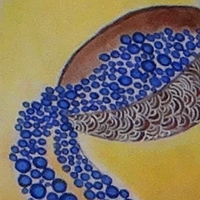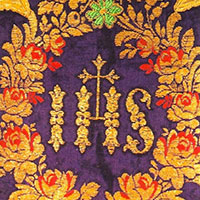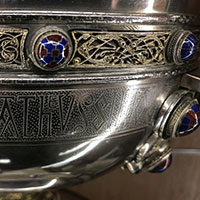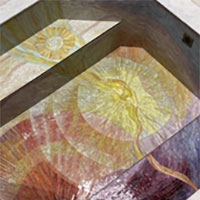 The term ‘liturgical banner’ evokes for most Catholics the static seasonal decorations we see on the walls of our churches. In the 1970s, these were often local amateur productions made by gluing felt cut-outs onto coloured hessian. More recently they have been mass-produced by religious goods companies. However, I would like to reflect on the liturgical banners which are carried in procession.
The term ‘liturgical banner’ evokes for most Catholics the static seasonal decorations we see on the walls of our churches. In the 1970s, these were often local amateur productions made by gluing felt cut-outs onto coloured hessian. More recently they have been mass-produced by religious goods companies. However, I would like to reflect on the liturgical banners which are carried in procession.
Continue reading “LITURGICAL BANNERS: Religious Processions”
Honouring God’s Creation
 Flowers in Church
Flowers in Church
One decorative item that plays an important atmospheric role in liturgical contexts is the floral arrangement. Natural flowers and plants have long been associated with celebrations of the liturgy – Eucharist, weddings, funerals – as well as devotions associated with the Blessed Virgin Mary and the Blessed Sacrament. This tradition sits well with influential voices such as Pope Francis; his encyclical Laudato Si’ has called for a renewed appreciation for the natural world as God’s gift, a blessing that is vital for our common, human life but also one that is vulnerable to misuse. Continue reading “Honouring God’s Creation”
A PLATYPUS STOLE AND A PELICAN CHASUBLE
 Charles Balnaves is Parish Priest at St Joseph’s parish in Meredith, a town 100km by road west of Melbourne. He had been involved with the Aboriginal Catholic Ministry (ACM) in the archdiocese for ten years. He wrote of the vestments designed by the ACM specifically to be placed into his custody on the occasion of his ordination. Continue reading “A PLATYPUS STOLE AND A PELICAN CHASUBLE”
Charles Balnaves is Parish Priest at St Joseph’s parish in Meredith, a town 100km by road west of Melbourne. He had been involved with the Aboriginal Catholic Ministry (ACM) in the archdiocese for ten years. He wrote of the vestments designed by the ACM specifically to be placed into his custody on the occasion of his ordination. Continue reading “A PLATYPUS STOLE AND A PELICAN CHASUBLE”
Holy Communion
 Rite and Vessels
Rite and Vessels
The form of communion vessels reveals something of our ritual practice. Conversely, change in the way we receive communion necessitates change in the kind of vessels we use. The small chalice and paten used so frequently over recent centuries are designed exclusively for the priest’s communion. Early communion vessels give us a glimpse of a differently organised communion rite in which everyone drank from a common cup and received part of the broken bread. These vessels carry a different understanding and liturgical theology. Continue reading “Holy Communion”
An Unexpected Heritage Treasure: The Chasuble
 My PhD research project at the University of Canberra, Treasured Threads: Ecclesiastical Textiles as Living Heritage of the Catholic Church in Australia (2019), grew out of my BA (Hons) dissertation which was inspired by three fragments of historical ecclesiastical embroidery salvaged from old, worn and damaged vestments made obsolete following the reforms of the Second Vatican Council. Vatican II reduced the number and type of ecclesiastical garments worn by clerics and simplified vestment design. As a result, a large amount of ecclesiastical textile heritage was removed from service. Visiting heritage textile collections and speaking with custodians has uncovered a diverse and unexpected web of community and personal significance and values that connect this living textile heritage to a broader web of local, national and international history and ongoing cultural life. Continue reading “An Unexpected Heritage Treasure: The Chasuble”
My PhD research project at the University of Canberra, Treasured Threads: Ecclesiastical Textiles as Living Heritage of the Catholic Church in Australia (2019), grew out of my BA (Hons) dissertation which was inspired by three fragments of historical ecclesiastical embroidery salvaged from old, worn and damaged vestments made obsolete following the reforms of the Second Vatican Council. Vatican II reduced the number and type of ecclesiastical garments worn by clerics and simplified vestment design. As a result, a large amount of ecclesiastical textile heritage was removed from service. Visiting heritage textile collections and speaking with custodians has uncovered a diverse and unexpected web of community and personal significance and values that connect this living textile heritage to a broader web of local, national and international history and ongoing cultural life. Continue reading “An Unexpected Heritage Treasure: The Chasuble”
Flynn Silver Communion Vessels
 St Francis’ Church, Lonsdsale St, Melbourne
St Francis’ Church, Lonsdsale St, Melbourne
In 1978, the two brothers, Dan Flynn BArch and John Flynn BSc, followed their father, also Dan Flynn, as silversmiths in a family business based in Kyneton, central Victoria. Their extensive array of ecclesiastical work began in 1947 when their father designed a chalice for his brother Leo, a Jesuit, to use at his ordination. Continue reading “Flynn Silver Communion Vessels”
Ernst Fries (1934-2020)
 Victorian sculptor Ernst Fries is known for his monumental works in stainless steel and granite, glass and concrete. He was born in Würzburg, Germany, and after a difficult childhood during World War II, studied gold and silver-smithing in Switzerland. He came to Australia in 1959. He settled in the Yarra Valley in 1986 where the landscape inspired him to explore themes of rebirth and new life in the elegant clean lines of his modern sculpture. With work in gallery collections in Australia and overseas, he has received many commissions for public sculpture, for example, in 2013, the glass and concrete panels of the Yarra Glen Black Saturday Memorial. Continue reading “Ernst Fries (1934-2020)”
Victorian sculptor Ernst Fries is known for his monumental works in stainless steel and granite, glass and concrete. He was born in Würzburg, Germany, and after a difficult childhood during World War II, studied gold and silver-smithing in Switzerland. He came to Australia in 1959. He settled in the Yarra Valley in 1986 where the landscape inspired him to explore themes of rebirth and new life in the elegant clean lines of his modern sculpture. With work in gallery collections in Australia and overseas, he has received many commissions for public sculpture, for example, in 2013, the glass and concrete panels of the Yarra Glen Black Saturday Memorial. Continue reading “Ernst Fries (1934-2020)”
Cardinal Moran’s Replica of the Ardagh Chalice
 The Ardagh Chalice is a superb and ornate example of early medieval Irish liturgical metalwork, dating from around the 9th century. Continue reading “Cardinal Moran’s Replica of the Ardagh Chalice”
The Ardagh Chalice is a superb and ornate example of early medieval Irish liturgical metalwork, dating from around the 9th century. Continue reading “Cardinal Moran’s Replica of the Ardagh Chalice”
A Garment and A Lighted Candle – A Long View
 Clothing and light are just two of a cluster of symbols that are at play in the Catholic rites of initiation and of farewell. Continue reading “A Garment and A Lighted Candle – A Long View”
Clothing and light are just two of a cluster of symbols that are at play in the Catholic rites of initiation and of farewell. Continue reading “A Garment and A Lighted Candle – A Long View”
Translucence of Light
 The inspiration of St Francis Xavier Cathedral in Geraldton, Western Australia, considered by some as one of the finest cathedrals built in the 20th century[i], can be found in the Arts and Crafts Movement of the late 19th and early 20th centuries. Among the principles of the Arts Crafts Movement is engagement of local builders, artists and crafts persons in the construction and decoration of buildings and the use of vernacular materials. Continue reading “Translucence of Light”
The inspiration of St Francis Xavier Cathedral in Geraldton, Western Australia, considered by some as one of the finest cathedrals built in the 20th century[i], can be found in the Arts and Crafts Movement of the late 19th and early 20th centuries. Among the principles of the Arts Crafts Movement is engagement of local builders, artists and crafts persons in the construction and decoration of buildings and the use of vernacular materials. Continue reading “Translucence of Light”
